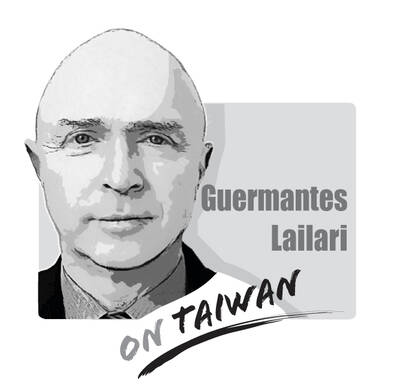Many in Taiwan were appalled by the news that a statue honoring Japanese engineer Yoichi Hatta in Tainan was found decapitated early on Sunday morning.
China Unification Promotion Party member and former Taipei city councilor Lee Cheng-lung (李承龍) yesterday turned himself in and confessed that he and a female accomplice were responsible for the vandalism.
Some commentators, pointing to previous cases of vandalism to statues of Chiang Kai-shek (蔣介石), asked whether the Hatta statue was targeted by anti-Japan or pro-unification supporters in a bid to take “a head for a head.”
Any form of vandalism or hateful act ought to be condemned, irrespective of the national or political identity that inspires it.
However, to equate the philosophy behind the erection of the Hatta statue with what led to the proliferation of Chiang statues around the nation is a serious error.
In addition, anyone trying to criticize Taiwan’s honoring of a Japanese as an act of “Japanization” that fawns on the nation’s past colonial rulers has failed to understand history and is interested only in inciting ethnic conflict.
To examine Hatta and Chiang from a purely historical standpoint, the two are worlds apart: Hatta never killed anybody. Chiang, on the other hand, was perceived by many Taiwanese as a murderer responsible for the bloody 228 Incident during which thousands of Taiwanese and Mainlanders perished; Hatta contributed to Taiwan with his planning and overseeing of the construction of Tainan’s Wushantou Reservoir (烏山頭水庫), whose irrigation network benefited the farmers of the Chianan Plain (嘉南平原); Chiang’s Chinese Nationalist Party (KMT) took over properties belonging to the former colonial government and private properties as party assets when the Japanese colonial government and settlers left Taiwan in 1945.
It is also worth noting that Hatta’s statue came about as a result of a public initiative; it was built and financed by his subordinates, whereas the countless Chiang statues around Taiwan were erected using taxpayers’ money and without the public’s consent.
A critic might say that Hatta’s construction of the Wushantou Reservoir was motivated by the then-colonial government’s concern over a stable rice supply. However, that Hatta’s engineering achievements helped lay the keystone of Taiwan’s modernization is indisputable.
Hatta, dubbed by Taiwanese as the “Father of the Chianan Irrigation System,” is remembered not only because of the reservoir — which dramatically increased the annual production of crops in the 150,000 hectare Chianan Plain which spans from Tainan through Yunlin and Chiayi counties and greatly improved the lives of tens of thousands of households in the region — but also because despite being an official of the colonial government, he showed humility toward the welfare of Taiwanese and did not oppress or exploit them as other colonial officials did.
The values behind the statues of the two are strikingly different: Hatta was apolitical and he earned the respect of Taiwanese via his selfless deeds; Chiang’s statues were erected to idolize the leader of a totalitarian regime.

There is much evidence that the Chinese Communist Party (CCP) is sending soldiers from the People’s Liberation Army (PLA) to support Russia’s invasion of Ukraine — and is learning lessons for a future war against Taiwan. Until now, the CCP has claimed that they have not sent PLA personnel to support Russian aggression. On 18 April, Ukrainian President Volodymyr Zelinskiy announced that the CCP is supplying war supplies such as gunpowder, artillery, and weapons subcomponents to Russia. When Zelinskiy announced on 9 April that the Ukrainian Army had captured two Chinese nationals fighting with Russians on the front line with details
Within Taiwan’s education system exists a long-standing and deep-rooted culture of falsification. In the past month, a large number of “ghost signatures” — signatures using the names of deceased people — appeared on recall petitions submitted by the Chinese Nationalist Party (KMT) against Democratic Progressive Party legislators Rosalia Wu (吳思瑤) and Wu Pei-yi (吳沛憶). An investigation revealed a high degree of overlap between the deceased signatories and the KMT’s membership roster. It also showed that documents had been forged. However, that culture of cheating and fabrication did not just appear out of thin air — it is linked to the
The Chinese Nationalist Party (KMT), joined by the Taiwan People’s Party (TPP), held a protest on Saturday on Ketagalan Boulevard in Taipei. They were essentially standing for the Chinese Communist Party (CCP), which is anxious about the mass recall campaign against KMT legislators. President William Lai (賴清德) said that if the opposition parties truly wanted to fight dictatorship, they should do so in Tiananmen Square — and at the very least, refrain from groveling to Chinese officials during their visits to China, alluding to meetings between KMT members and Chinese authorities. Now that China has been defined as a foreign hostile force,
On April 19, former president Chen Shui-bian (陳水扁) gave a public speech, his first in about 17 years. During the address at the Ketagalan Institute in Taipei, Chen’s words were vague and his tone was sour. He said that democracy should not be used as an echo chamber for a single politician, that people must be tolerant of other views, that the president should not act as a dictator and that the judiciary should not get involved in politics. He then went on to say that others with different opinions should not be criticized as “XX fellow travelers,” in reference to